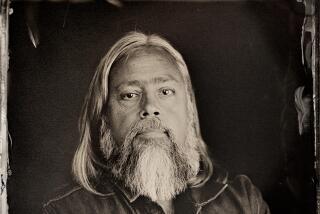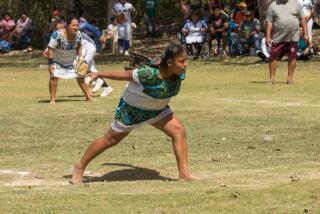The Beat Goes on for Manufacturer of Native American Drums : Culture: Craftsmen at Taos Drums in New Mexico make about 20,000 a year--some big as coffee tables, others hand-sized. Not one sounds alike.
TAOS, N.M. â Indian drum maker Mike Kopepassah cuts a spiral rawhide thong from a wet pelt, then laces it through holes in saturated cowhides stretched over and under a gnarled, hollowed-out cottonwood stump.
The hides will dry and shrink tight, turning the stump into one of about 20,000 drums produced every year by craftsmen at Taos Drums and sent out worldwide.
Some of the companyâs drums weigh hundreds of pounds, cost thousands of dollars and double as coffee tables. Others can be held in a childâs hand or hung on the wall as art.
Tapping one finger on any of the larger drums stacked here in profusion produces a deep, resonant tone reminiscent of a bull fiddle--or a bull fiddle echo.
And visitors are invited to tap, company owner Bruce Allen says.
âWe have kidsâ groups who come in. We let them play the drums and also let them make drums,â Allen, 49, said during a tour of his 22,000-square-foot factory and showroom on a recent snowy day. âNow that we have a front area open to the public, we invite people to drum.
âA drum is a drum is a drum--itâs meant to be used; itâs not just an item to be put on the wall or the floor to be viewed.â
The drum shells are generally made of cottonwood, aspen, pine or fir, although Allen says pine and fir trunks have grown smaller while costs have skyrocketed.
So the largest drums are usually cottonwood. The skins may be cow, elk, deer, buffalo, goat or sheep.
Allen, a Yale University anthropology graduate who had worked as an economic development consultant for several Indian pueblos, bought the business in 1981 after its founders decided to sell. The original owners--ranchers who sold firewood and a meat-cutter who had accumulated cow and elk skins as byproducts--had put the two areas together for drum-making, Allen said.
Allen said his staff of 40-plus, more than one-third Native Americans, has grown more than tenfold since he took over.
Non-Indian employees work in such jobs as clerks and woodworkers, but the companyâs drums always have been made by Native Americans.
âIn Taos, a lot of people made drums. Itâs something which is still part of the local culture and tradition,â Allen said.
Kopepassah, 40, half Kiowa and half Taos Indian, has been around Indian drums all his life, although he only started making them about three or four years ago. What he likes best, he said, is the variety of tones.
âWe have no control over how itâs going to sound,â he said.
Working with him is Jonald Lowe, 24, a Navajo from Fruitland, N.M., who is married to a Taos Pueblo woman. Lowe started working here immediately after graduating from high school.
âI started out peeling bark and worked my way up [to drum maker],â Lowe said.
Allen said the appeal of drums cuts across all kinds of divisions--cultural as well as musical. While music is the universal language, he says, drums take it a beat deeper--to a universal primal language.
The call of the drumbeat traditionally brings people together, said Allen, who sells drums to Indian dance and music groups from various tribes as well as to other drummers, collectors and tourists.
The company makes large Pueblo Indian drums and more portable Sioux-style drums, some painted with Indian designs, some plain.
The big drums, which follow the contours of substantial tree trunks, are based on kiva drums, Allen said. Those are the drums that Pueblo Indians place in their religious kivas, which are circular underground retreats.
âAn unusually shaped tree . . . produces a drum thatâs very irregular, not round. Some people like that quite a bit,â Allen said. âA lot of people will use a drum this size as a table.â
Table drums range up to eight feet across and take up to two years to make, including a year or more to dry the wood.
The largest are hollowed with chain saws. Others are bored out on a hole-saw press.
Allen even offers a trap drum set for drummers playing any contemporary studio music.
âRawhide has a tone which you really cannot reproduce with any other drumhead,â he said.
In 1990, Taos Drums was destroyed by fire when a machinery spark ignited sawdust.
âIt was a complete loss: nothing left, no accounts, no wood, no hides, no building,â Allen said.
But his customers wouldnât let the company die, he said.
âThey sent us orders for the next year and said, âJust send it to us whenever you can.â Some sent prepayments, and we were really buoyed by the reinforcement that people elsewhere understood what we were trying to do here.â
The company reopened two years later at its new location south of town on U.S. 68.
âThe drum is the heartbeat of Mother Earth, and as such, itâs a focus not only of ceremony but a spiritual focus on Mother Earth and the central role, the primary role that she plays,â Allen said.
âI think that people who live in Taos, people from Taos Pueblo, have an understanding of this and a closeness to the natural roots of our community that has often been lost in the rest of the country. . . . There is an integrity here--not simply a longing for what has been lost, but a recognition that it hasnât been lost.â
More to Read
Sign up for The Wild
Weâll help you find the best places to hike, bike and run, as well as the perfect silent spots for meditation and yoga.
You may occasionally receive promotional content from the Los Angeles Times.






